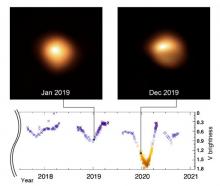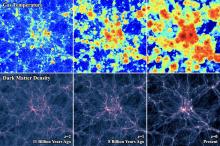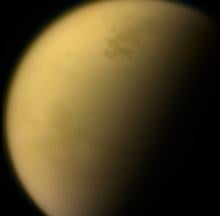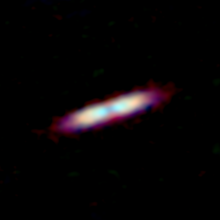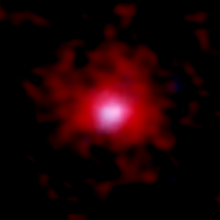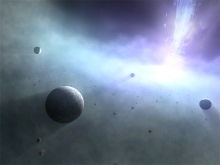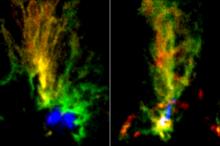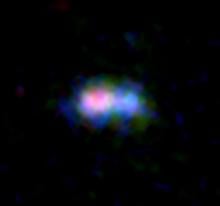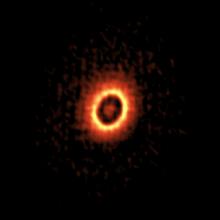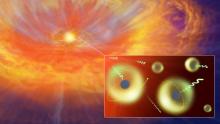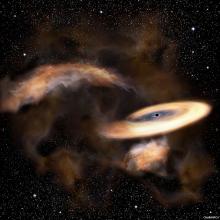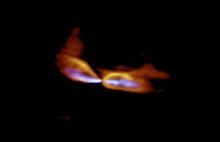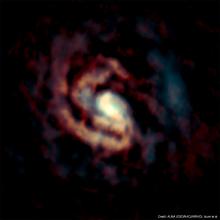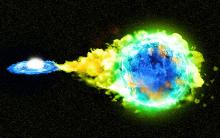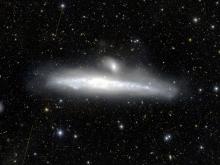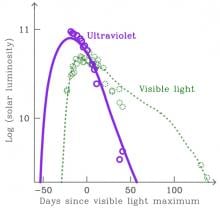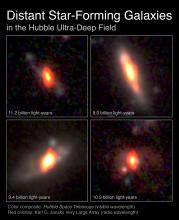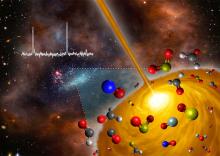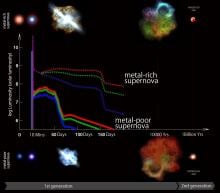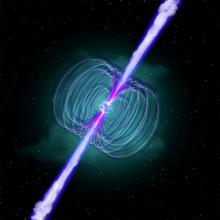Astrophysical Journal
News
08 Feb 2021
Betelgeuse is normally one of the brightest, most recognizable stars of the winter sky, marking the left shoulder of the constellation Orion. But lately, it has been behaving strangely: an unprecedentedly large drop in its brightness has been observed in early 2020 (Figure 1), which has prompted speculation that Betelgeuse may be about to explode.
13 Nov 2020
How hot is the Universe today? How hot was it before? A new study by an international team of researchers, including members of the Kavli Institute for the Physics and Mathematics of the Universe (Kavli IPMU), suggests that the mean temperature of gas in large structures of the Universe has increased about 3 times in the last 8 billion years, to reach about two million Kelvin today.
14 Feb 2020
Planetary scientists using ALMA revealed the secrets of the atmosphere of Titan, the largest moon of Saturn.
23 Dec 2019
Astronomers using the Atacama Large Millimeter/submillimeter Array (ALMA) found a young star surrounded by an astonishing mass of gas.
16 Dec 2019
Researchers have discovered gigantic clouds of gaseous carbon more than a radius of 30,000 light-years around young galaxies using ALMA.
25 Nov 2019
Theoreticians in two different fields defied the common knowledge that planets orbit stars like the Sun. They proposed the possibility of thousands of planets around a supermassive black hole.
14 Nov 2019
Two peacock-shaped gaseous clouds were revealed in the Large Magellanic Cloud by observations with Atacama Large Millimeter/submillimeter Array.
20 Mar 2019
Researchers have detected a radio signal from abundant interstellar dust in MACS0416_Y1, a galaxy 13.2 billion light-years away in the constellation Eridanus. Standard models can’t explain this much dust in a galaxy this young, forcing us to rethink the history of star formation.
13 Mar 2019
Researchers spotted the formation sites of planets around a young star resembling our Sun. Two rings of dust around the star, at distances comparable to the asteroid belt and the orbit of Neptune in our Solar System, suggest that we are witnessing the formation of a planetary system similar to ours.
13 Mar 2019
A team of experts in nuclear fusion and astronomy has computed high-accuracy atomic data for analyzing light from a kilonova, a birth place of heavy elements. They found that their new data set could predict kilonovae brightness with much better accuracy than before. This aids our understanding of the cosmic origins of heavy elements.
28 Feb 2019
Astronomers have detected a stealthy black hole from its effects on an interstellar gas cloud. This intermediate mass black hole is one of over 100 million quiet black holes expected to be lurking in our Galaxy. These results provide a new method to search for other hidden black holes and help us understand the growth and evolution of black holes.
26 Feb 2019
Astronomers have unveiled the origins of two different gas streams from a baby star. Using ALMA, they found that the slow outflow and the high speed jet from a protostar have misaligned axes and that the former started to be ejected earlier than the latter. These indicate that streams were launched from different parts of disk around the protostar.
30 Nov 2018
Based on computer simulations and new observations from ALMA, researchers have found that the rings of gas surrounding active supermassive black holes are not simple donut shapes. Instead, gas expelled from the center interacts with infalling gas to create a dynamic circulation pattern, similar to a water fountain in a city park.
27 Sep 2018
Researchers have found white dwarf stars with masses close to the maximum stable mass are likely to produce large amounts of manganese, iron, and nickel after it orbits another star and explodes.

14 Feb 2018
Thermodynamics provides insight into the internal energy of a system and the energy interaction with its surroundings. This relies on the local thermal equilibrium of a system.
13 Oct 2017
Dwarf galaxies and star-containing halos in a large spiral galaxy 25 million light-years away from Earth have been identified using a Japanese telescope in Hawaii.
07 Sep 2017
An international team of researchers led by Kavli IPMU's Alexey Tolstov and Ken'ichi Nomoto have discovered a way to use UV light from superluminous supernovae to uncover its explosion mechanism, and used it to identify Gaia16apd as a shock-interacting supernova, reports a new study.
12 Apr 2017
Astronomers have gotten their first look at exactly where most of today’s stars were born. To do so, they used the National Science Foundation’s Karl G. Jansky Very Large Array (VLA) and the Atacama Large Millimeter/submillimeter Array (ALMA) to look at distant galaxies seen as they were some 10 billion years ago.

03 Apr 2017
A mysterious flash of X-rays has been discovered by NASA’s Chandra X-ray Observatory in the deepest X-ray image ever obtained. This source likely comes from some sort of destructive event, but may be of a variety that scientists have never seen before.
06 Oct 2016
Astronomers have discovered a 'hot molecular core,' a cocoon of molecules surrounding a newborn massive star, for the first time outside our Galaxy.
12 Jul 2016
An international collaboration led by the Kavli Institute for the Physics and Mathematics of the Universe (Kavli IPMU) have discovered that the color of supernovae during a specific phase could be an indicator for detecting the most distant and oldest supernovae in the Universe - more than 13 billion years old.
24 Mar 2016
Kavli IPMU of The University of Tokyo, Japan, and Instituto de Astrofisica de La Plata, Argentina, scientists have found highly magnetized, rapidly spinning neutron stars called magnetars could explain the energy source behind two extremely unusual stellar explosions.
25 Jan 2016
For the first time, an international team of researchers has found that the connection between a galaxy cluster and surrounding dark matter is not characterized solely by the mass of clusters, but also by their formation history.
10 Oct 2013
A novel ‘magic’ number of neutrons corresponding to a particular substructure of atomic nuclei is reported in Nature this week. New insights into the structures of atomic nuclei can help us to understand astrophysical processes, such as the creation of atomic nuclei in stars.

04 Dec 2012
A research group of University of Tsukuba, RIKEN, and Tokyo Institute of Technology announced that the ACM Gordon Bell Prize (*1) was awarded to that group.

26 Jan 2012
Latest news from Nature 26 January 2012
03 May 2011
Newly available data on rare, neutron-rich isotopes reveal shortcomings of models describing the synthesis of elements

13 Oct 2010
Summaries of newsworthy papers include: ‘Til kingdom come; Cold gas feeding distant galaxies; Formation of the blood–brain barrier; Feast, famine and the evolution of sex; Organic aerosols firm up, When is a comet not a comet?

17 Feb 2010
Summaries of newsworthy papers: Cancer and copy number, General relativity tested in the lab, Multi-wavelength view of an astrophysical jet, iPS to understand diseases, Supernova progenitors constrained by their X-rays and Learning to sing changes the brain
Events
Sorry, no events coming up for this topic.
Researchers
Sorry, no researchers coming up for this topic.
Giants in history
Sorry, no researchers coming up for this topic.


